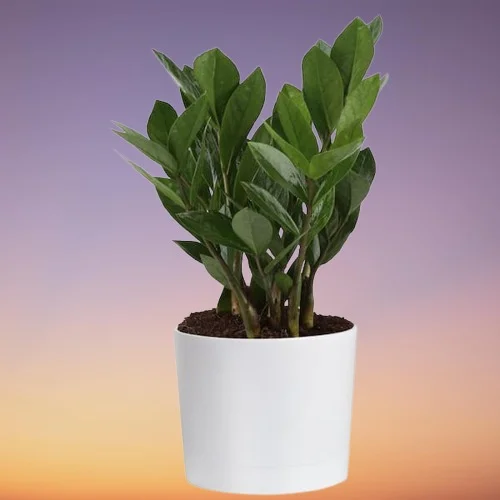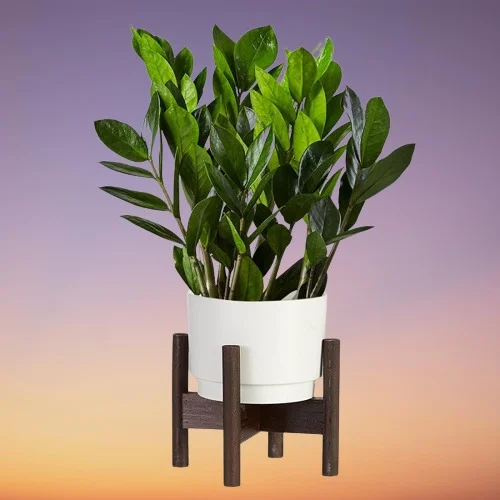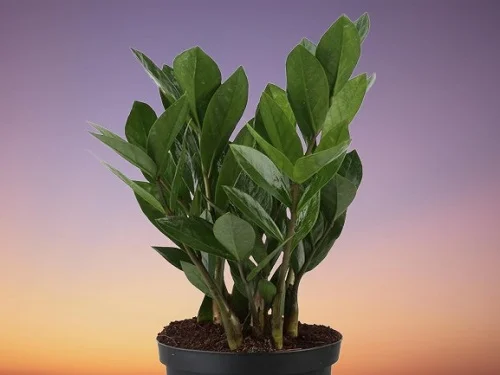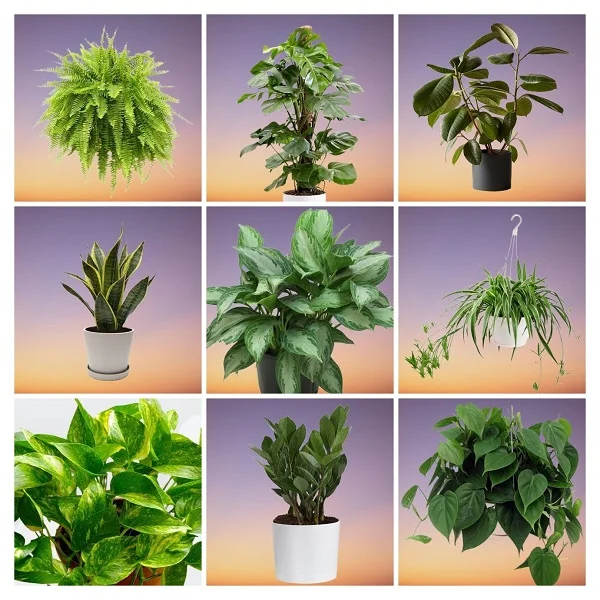How to Care for ZZ Plant (Zamioculcas zamiifolia) Indoors
Some links in this post may be affiliate links
ZZ Plant (Zamioculcas zamiifolia) prefers bright indirect light away from direct sunlight (partial shade), average warmth, moderate humidity and moderately moist, rich, succulents potting soil coupled with monthly feeding in the growing season.
Zamioculcas zamiifolia also called Zanzibar Gem, Zuzu Plant, Aroid Palm or Emerald Palm is one of the hard to kill plants as it is highly tolerant to low light and dry conditions.
Zanzibar Gem is a compact plant with attractive glossy foliage and is among the popular plants for the limited spaces in the home and office space.
The foliage in Zuzu Plant contains unusually high content of water up to 90% and has an individual leaf longevity of at least 6 months. This explains why the plant can survive extremely well under interior low light levels for up to 4 months without water. It is one of the best drought-tolerant plants for any space.

Botanical name: Zamioculcas zamiifolia
Family: Araceae
Common names: ZZ Plant, Zanzibar Gem, Zuzu Plant, Aroid Palm, Emerald Palm
Origin
ZZ Plant is the only member of the Zamioculcas genus in the family Araceae. It is a tropical perennial plant native to Eastern Africa, from Kenyan South to Northeastern South Africa. It is among the popular tropical foliage plants that you can grow successfully in any space.
Size
ZZ Plant is a compact plant which grows to a height of 90 cm from a stout underground succulent rhizome. The leaves are pinnate, 40-60 cm long, with 6-8 pairs of leaflets 7-15 cm long; they are smooth, shiny and dark green. The foliage is borne on upright, slightly arching stems which are thickened at the bottom.
Flowers
The flowers in Zanzibar Gem are small, bright yellow to brown or bronze spadix about 5-7 cm long and are partly hidden among the leaf bases.
Air Cleaning
A study done by Department of Plant and Environmental Science at the University of Copenhagen from 2014 shows that ZZ Plant is a good indoor air cleaner; effective in getting rid common household pollutants like benzene, toluene, xylene and ethylbenzene from indoor air. It is among the best plants for for a study desk as it boosts concentration.
Toxicity
The foliage of ZZ Plant (Zamioculcas zamiifolia) is toxic to both humans and pets. If ingested it can cause pain and burning in the mouth and throat, vomiting, diarrhea and abdominal pains. Contact with the plant sap may cause skin irritation or skin rash in sensitive skin therefore always wear gloves when handling the plant. Keep the plant from the reach of children and pets.
Where to Buy
Would you like to add Zanzibar Gem to your collection? They are available online on Amazon (Link to Amazon).
Zamioculcas zamiifolia Care Indoors
ZZ Plant (Zamioculcas zamiifolia) prefers bright indirect light (partial shade), average warmth of 15-260C, moderate humidity of 50-55% and moderately moist, fertile, succulents potting soil coupled with monthly feeding during the growing season.
Emerald Palm does not require regular repotting as it is a slower grower which needs to be repotted only when pot-bound. Pruning is necessary to keep the plant neat as well as discourage pest and disease infestations. Keep reading for more on these growing conditions and how to provide them.

Light Requirements
ZZ Plant grows best in bright, indirect light (light shade). Keep it away from direct sunlight as it can cause sun scorch on the leaves. It can also tolerate lower light but it will grow more slowly.
However, too little light will cause it to grow weak with elongated stems in an attempt to reach the light source. Therefore, instal a grow light if the light is too low. Take a look at these full spectrum grow lights on Amazon.
Rotate the pot regularly to ensure that the plant receives light on all sides for uniform growth and prevent lopsided growth.
Watering
Water ZZ Plant thoroughly during the growing season and allow the top 2-3 inches of soil to dry out between waterings to keep the soil moderately moist.
Significantly, cut down on watering in the cold season to maintain the soil barely moist as growth is minimal at this time but do not let the soil dry out completely.
Ensure that the pot has a drainage hole and that the soil is well-drained to prevent the soil from getting soggy as it can lead to rotting of the rhizomes.
Temperature and Humidity
Average warmth of 15-260C is ideal for ZZ Plant. A room temperature that is comfortable for you is ideal for this plant. Keep it away from drafts as they can cause leaf drop.
ZZ Plant has no need for extra humidity. Average room humidity of 505-55% is ideal for this plant. However, ensure that there is good air circulation to prevent fungal diseases infestations.
Clean the leaves regularly by damp-wiping with a soft cloth to keep them clean and neat as well as discourage pest and disease infestations.
Fertilizer
Feed ZZ Plant monthly during the growing season with a balanced, liquid fertilizer. The plant is not a heavy feeder so be careful when feeding to avoid overfeeding. Do not in the cold season as growth is minimal as feeding at this time can cause fertilizer burn.
Potting Soil
The best soil for ZZ Plant should be rich in organic matter, loose and free-draining to avoid getting soggy soil. The soil should be loose enough to allow water to drain out fast enough. Cactus and succulents soil is ideal for plant as it drains easily. Check out these 12 succulents potting soil mixes.
Repotting
ZZ Plant is a slow-grower so frequent repotting is not necessary. Repot the plant at the beginning of the growing season only when it becomes crowded in its current pot. Repot into a pot only 1 size larger and one that has a drainage hole to prevent the soil from getting soggy as it can lead to rotting. Take a look at these succulents pots on Amazon.
Pruning
Pruning ZZ Plant involves removal of any dead leaves and bare stems to keep the plant neat and tidy. The timely removal of dead leaves and bare stems also reduces pests and disease infestations.
Propagation
ZZ Plant (Zamioculcas zamiifolia) propagation can be done at the beginning of the growing season from leaf cuttings or by division of the rhizomes.
How to propagate ZZ Plant from leaf cuttings
Cut off a leaf complete with the petiole from a healthy ZZ Plant.
Insert the leaf petiole into moist, well-drained soil and enclose the pot in polythene to create a greenhouse effect.
Place the set up in a warm place and maintain the soil moist through out. The leaf cutting may take several months to develop roots.
Once new plantlets have formed at the base, carefully seperate them and pot in individual pots.
Place the pots in a warm, well-lit place and maintain the soil moist until the new Aroid Palm is well established after which routine care can begin.
How to propagate ZZ Plant by plant division
Take out the ZZ Plant from its pot. Clear most of the soil from the roots.
Carefully divide the ZZ plant rhizome into several sections by cutting with a sharp sterilized knife.
Ensure each section bears at least two shoots and adequate roots to hasten establishment.
Pot the sections into individual pots and place in a warm, well-lit place away from direct sunlight.
Maintain the soil moist through out until the new Emerald Palm is well established after which routine care can begin.

Zamioculcas zamiifolia Common Problems
ZZ Plant (Zamioculcas zamiifolia) growing problems include yellow leaves, leggy growth, leaf drop, rotting, pests and diseases among others. Keep reading for more on these problems, their remedies and solutions.
Pests
ZZ Plant is very resistant to pests but weak plants can be attacked by mealy bugs, aphids, scales and spider mites. Isolate the affected plant to prevent spread to other plants and treat it with neem oil or insecticidal soap as per the manufacturer's instructions.
Diseases
ZZ Plant is prone to root-rot disease which is brought about by soggy soil. Ensure that the pot has a drainage hole and the soil is free-draining to prevent the soil from getting soggy. Read more on how to treat root-rot disease in houseplants.
Yellow leaves
There are two possible causes of yellow leaves in ZZ Plant. One possible cause of yellow leaves in Zuzu Plant is incorrect watering; either underwatering or overwatering.
Water the plant thoroughly during the growing season and allow the top 2-3 inches of soil to dry out between waterings. Reduce watering in the cold season but do not allow the soil to dry out completely.
In addition, ensure that the pot has a drainage hole to prevent the soil from getting soggy as it can lead to rotting of the rhizome and roots which result in yellow leaves. Read more on how to water houseplants the correctly.
The second possible cause of yellow leaves in Aroid Palm is overfeeding. The plant is not a heavy feeder therefore be careful in feeding this plant. Feed it monthly during the growing season with a balanced, liquid fertilizer but withhold feeding in the cold season as growth is minimal at this time. Learn more on how to feed houseplants.
Leggy growth (elongated stems)
Leggy growth (elongated stems) in ZZ Plant is caused by too little light. Though the plant can tolerate some shade, it will not thrive in deep shade. Too little light will cause it to grow weak with elongated stems in an attempt to reach the light source. Move the plant to a brighter spot as it grows best in bright indirect light. Check out this post on understanding light for houseplants.
Sudden leaf drop
Sudden leaf drop in ZZ Plant is caused by underwatering. Aroid Palm will shed the leaves to conserve water if the soil is too dry. Water the plant thoroughly during the growing season and allow the top 2-3 inches of soil to dry out between waterings to maintain the soil moderately moist. Cut down on watering in the cold season to keep the soil slightly moist but never allow the soil ball to dry out completely.
Yellow foliage and soft stems
Yellow foliage and soft stems in ZZ Plant are due to overwatering. This is an indication that the rhizome may have started rotting. Decrease watering to maintain the soil moderately moist but not soggy. Ascertain that the soil is free-draining and the pot has a drainage hole to prevent the soil from getting soggy.
Brown leaves
Brown leaves in ZZ Plant are due to exposure to direct sunlight and are an indication of sunscorch. Protect the plant from or keep it away from direct sunlight to avoid sun scorch on the leaves.
You liked it? Share on social media.
Related Content
Amazon Associates Disclosure
Homeplantsguide.com is a participant in the Amazon Services LLC Associates Program, an affiliate advertising program designed to provide a means for sites to earn advertising fees by advertising and linking to amazon.com.





